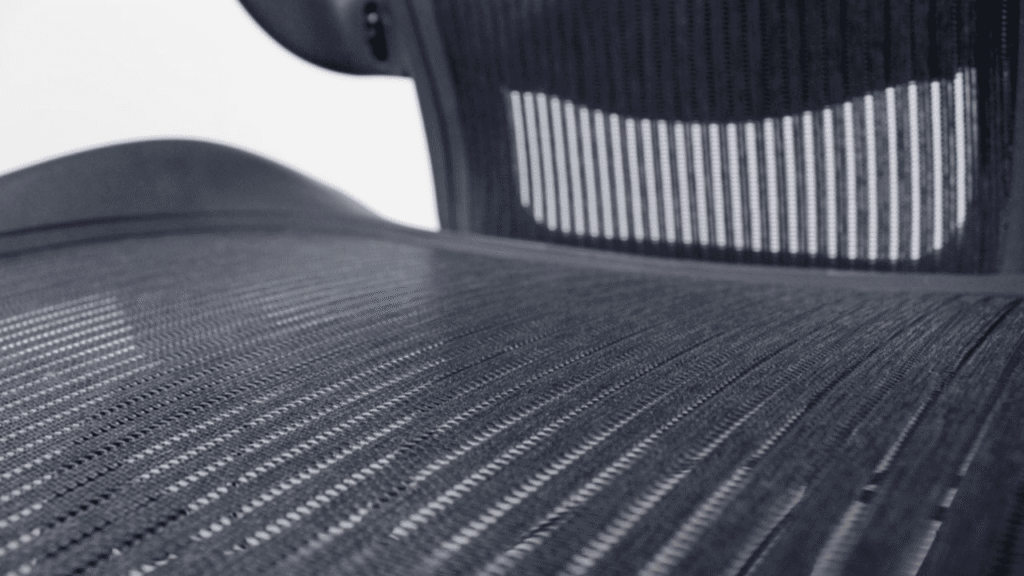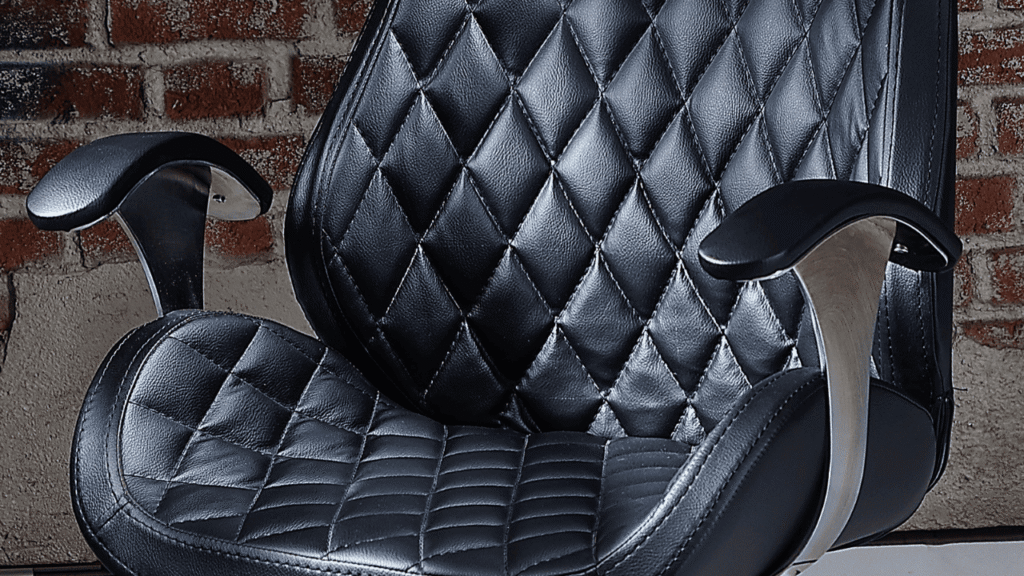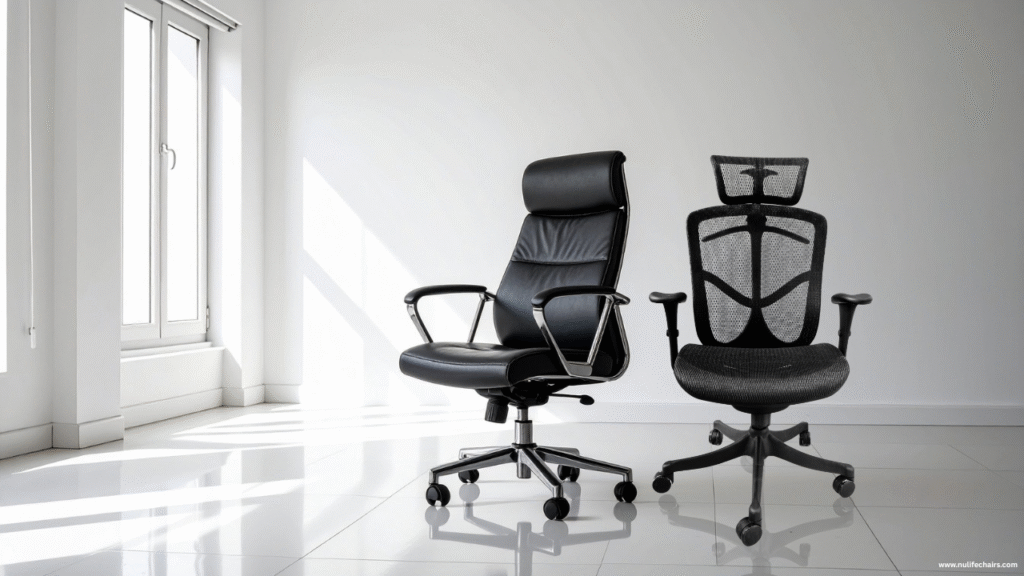Choosing the right office chair is crucial for long-term comfort and cost-efficiency, especially as ergonomic office chairs become a staple in modern workspaces. With a surge in remote work – for example, about 22% of U.S. workers (32.6 million people) remain fully remote – home offices are more common than ever. Long hours at the desk and varying body weights mean that chair durability and support really matter. In fact, factors like high daily use and exceeding a chair’s weight limit can significantly shorten its lifespan.
Table of Contents
ToggleMesh vs Leather Office Chairs
Modern breathable mesh chairs offer a contemporary look and excellent airflow, whereas leather chairs bring a classic, executive style. To see the difference, consider these examples:
A modern mesh office chair with an open-weave design, offering better ventilation.
A classic black leather executive chair with plush cushioning and a traditional look.
Aesthetics & Materials: Mesh chairs usually have a sleek, minimalist design with a synthetic fabric back and seat. Leather chairs often use thick cushioned seats covered in genuine or faux leather, projecting a luxurious executive vibe. Genuine leather (full-grain or top-grain) is durable, while bonded or PU leather is far less so.
- Breathability: Mesh chairs excel in airflow. The open-weave, breathable mesh lets air circulate, keeping you cool. Leather chairs, on the other hand, can retain heat, making them warmer in long use.
- Cost: Mesh office chairs often come at lower price points; genuine leather chairs tend to be more expensive. However, a cheap leather chair (especially bonded leather) may not last as long as a well-made mesh chair.
- Maintenance: Mesh is relatively low-maintenance – you can vacuum or wipe it clean. Leather demands more care: regular chair maintenance like wiping with a damp cloth and conditioning to stay supple.
- Durability: Generally, mesh chairs last about 5–8 years with regular use. A well-cared-for leather chair can last 7–15 years (some top-grain models even longer). But faux leather (bonded or PU) tends to show wear faster (often only 3–5 years).
- Support & Ergonomics: Both types can be part of ergonomic office chairs. Mesh backs are flexible and often come with built-in lumbar support, conforming to your spine. Leather chairs usually have firmer padding; as the foam cushions age, seat cushion durability (foam resilience) can become a concern, whereas mesh seats rely on tension.
Durability Comparison
Material Lifespan
When it comes to office chair lifespan, material plays a big role. Mesh chairs often last around 5–8 years under regular use. For example, Herman Miller’s Aeron chair (mesh) is tested to meet rigorous durability standards, simulating years of use. In contrast, genuine leather chairs (full-grain or top-grain) can endure 7–15 years with proper care, and top-quality leather can even last decades. Leather quality matters: bonded leather and PU (faux leather) degrade much faster. Bonded leather, made from shredded scraps glued together, typically lasts only about 3–5 years before peeling or flaking. As one source notes, “bonded leather can only last about 3–5 years even with care.” Genuine leather will outlast any bonded product, and forum users often warn that cheap faux leather seats crack and peel after just a few years.
Wear & Tear Resistance
Mesh chairs are generally durable, but they can show wear under stress. Lower-quality mesh or overloaded chairs may lose tension or tear. As one user observed, “low quality mesh like on the [Hyken] tends to sag”. Overloading a mesh chair (sitting with extra force or exceeding weight limits) can locally tear the mesh, causing sagging. High-end mesh chairs use industrial-grade fibers that resist stretching, and their frames (steel or reinforced plastic) ensure stability.
Leather chairs wear differently. Genuine leather develops a natural patina but is tough against punctures. It does not sag, but it can crack or peel if dried out or damaged. Bonded or faux leather is much more prone to such damage. A leather-care guide explains that bonded leather is “less durable and more likely to peel over time,” and faux leather (PU) “lacks natural oils, making it prone to cracking and peeling”. In other words, a cheap leather chair may look brand-new for a couple of years but can quickly look worn afterward.
Maintenance Needs
All chairs need care, but maintenance differs by material. Mesh chairs are low-maintenance: they resist stains, dry quickly, and need only routine vacuuming or dusting to remove debris, plus spot-cleaning with mild detergent if needed. Experts recommend a vacuum with an upholstery attachment and a gentle solution of warm water with mild dish soap (even a bit of white vinegar) for stains. Leather chairs demand more attention—dirt and oils can dull or dry the surface, so frequent dusting with a soft cloth is essential. Use a damp cloth with gentle leather cleaner or mild soap for deeper cleaning, and apply a quality conditioner every few months to restore moisture and prevent cracking. Avoid direct sunlight and heat, which can fade or crack leather. In summary, mesh needs simple cleaning (vacuum and wipe) while leather benefits from regular care (clean and condition).
Long-Term Comfort Evaluation
Breathability & Temperature Control

Comfort isn’t just about padding – temperature matters. Mesh chairs allow air to flow, keeping you cool and comfortable, especially in warm climates or if you run hot.
Leather chairs, by contrast, can feel warm. Leather and faux-leather surfaces are essentially impermeable to air.

In hot weather or under the sun, a leather seat can quickly heat up. As one expert notes, “during prolonged use, leather tends to retain heat, which can be challenging in warmer environments.” Without strong A/C, you might end up sweating on a leather chair, though in a cold office it can feel warmer against your body.
Ergonomics & Support
Both mesh and leather chairs can be highly ergonomic, but the support feels different. Quality mesh chairs are very adjustable—the back flexes and contours to your spine, often with built-in or adjustable lumbar support to match your posture. Premium models “support the back and spine, encouraging healthy posture,” and their flexible mesh spreads weight evenly to reduce pressure points. Leather chairs use foam padding under the leather, feeling firm at first and softening with body heat. Well-made executive chairs include ergonomic features like adjustable seat height, tilt, armrests, and lumbar pads. Leather feels cushioned but foam can flatten over time, while mesh has no foam to break down—though its tension can stretch. Top ergonomic options like the Herman Miller Aeron (mesh) and Steelcase Leap (leather) show both materials can provide lasting comfort. Preference is personal: mesh offers a breathable “hug,” leather a solid cushion. Ultimately, design quality matters more than the covering.
Sustainability & Environmental Impact
Production and end-of-life impacts differ sharply between mesh and leather. Leather production has a significant environmental footprint. It starts with livestock: cattle farming is resource-intensive, accounting for about 14.5% of global greenhouse gas emissions and driving deforestation. The tanning process is highly water- and chemical-intensive, often involving toxic chromium that pollutes water sources. As noted, leather production is “highly water-intensive” and a major source of pollution. In short, animal-based leather is resource-intensive and can contribute to environmental harm if not managed carefully.
Mesh fabric, Mesh is typically synthetic (nylon, polyester, etc.) and derived from petroleum, using fossil fuels and energy but avoiding the animal agriculture footprint. However, it’s not biodegradable, hard to recycle, and many mesh chairs end up in landfills—so while it skips leather’s land and water impact, it still carries a pollution cost from plastic production.
A sustainable solution is choosing refurbished chairs. Reconditioning a used mesh or leather chair reduces waste and “positively impacts the environment by conserving valuable resources.” With about 9 million tons of furniture discarded in U.S. landfills each year, reusing or buying high-quality used chairs helps keep materials in use. Choosing durable chairs or those made from recycled or renewable materials further supports sustainability.
Best Use Cases for Each Type
- Home Office vs. Corporate: Both mesh and leather chairs have their place. Many home offices favor mesh chairs for their modern look, breathability (especially if AC isn’t strong), and affordability. Corporate or executive offices often feature leather chairs for a traditional professional appearance. That said, it’s very common to see high-quality mesh chairs in offices that prioritize ergonomics and leather chairs in home offices of users who prefer the classic look.
- Hot Climates vs. Cold Climates: In hot and humid climates (or warm indoor environments), a mesh chair is generally more comfortable because it stays cool. In very cold climates, a leather chair can feel warmer to sit on in winter. Some people even use a towel or cushion to bridge the gap. If you’re torn, one strategy is to choose mesh for summer and use a sweater or blanket as needed; with leather, you might want a fan or lighter clothing in summer.
- Heavy Daily Use vs. Occasional Use: If you sit 8+ hours every day, investing in a high-quality chair of either type is wise. A premium leather chair (and the extra care it requires) can be worthwhile if you’ll use it intensively for years. However, a top-end mesh ergonomic chair can offer the same multi-year support with arguably less maintenance. For very light or occasional use (e.g., a second home office), a mid-range mesh or bonded leather chair may suffice, balancing initial cost and comfort without expecting decades of life.
Conclusion
Both mesh and leather office chairs have pros and cons. Genuine leather can last a decade or more with care, while high-quality mesh chairs serve about 5–8 years. Cheaper leather (bonded/PU) deteriorates faster, around 3–5 years.
Mesh wins on breathability, keeping you cool, while leather offers a plush, luxurious feel that can get warm. Mesh is easy to clean, while leather needs regular cleaning and conditioning.
Mesh chairs are usually cheaper upfront, but a well-made leather chair can be a lasting investment. Ergonomics depend more on design than material—both can provide excellent support.
Choose based on priorities: mesh for cooler comfort, leather for longevity and style. For sustainability, refurbished chairs (mesh or leather) reduce waste. Ultimately, pick a high-quality chair that fits you well.
Frequently Asked Questions
Is mesh or leather better for hot weather?
Mesh chairs are typically better in hot weather due to their breathability. The open-weave breathable mesh allows air circulation and heat dissipation. In contrast, leather seats can feel warmer and trap body heat during prolonged use.
Which type of chair is easier to clean, mesh or leather?
Both can be cleaned, but in different ways. Leather’s smooth surface means spills can be wiped away easily with a damp cloth. Mesh fabric is more prone to dust and crumbs, so it benefits from regular vacuuming or dusting. Treat stains on mesh with gentle soap and water; for leather, use a pH-neutral cleaner and condition the leather to prevent drying.
What’s the most common issue with mesh chairs over time?
The most common issue reported is sagging or loss of tension in the mesh, especially on cheaper chairs. Users note that “low quality mesh… tend to sag” after a couple of years. Overloading a mesh chair can also tear the mesh. Investing in a quality mesh (like the Aeron) mitigates this risk.
Is bonded leather worth it compared to genuine leather?
Generally, bonded leather is not worth it if durability is important. Bonded leather is made of leather scraps glued together, so it wears out much faster. It typically lasts only a few years before peeling or flaking. Genuine leather costs more but ages much better and can last a decade or more.
Do mesh chairs offer enough lumbar support?
Yes, most quality mesh chairs offer excellent lumbar support. In fact, many ergonomic mesh chairs are designed with built-in or adjustable lumbar support to fit your spine. The mesh itself conforms to your lower back’s curve, and high-end models have adjustable lumbar pads, so mesh chairs can be just as supportive – or even more so – than leather chairs in the long run.


